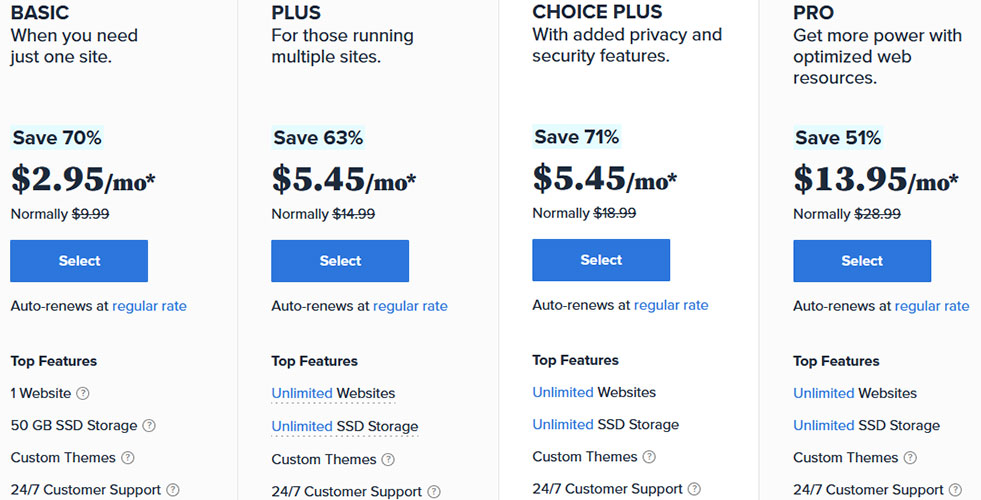Inodes represent the files on your hosting account. All hosting providers use a data structure in the form of inodes to store information about all the files you create.
Each of your files, folders, emails, email attachments, images, and videos denote a single inode. The total number of inodes remains equal to the number of files, folders, and other content you have on your hosting account.
So let’s find out more about everything there is to know about Bluehost inode limit.
What is the Bluehost inode limit?
Bluehost allows up to 50,000 inodes for each shared hosting account. The host is capable of delivering optimal server performance within this limit.

The above Bluehost inode limit applies to all the shared, WordPress, and WooCommerce hosting plans offered by the host. The only exception lies with the Pro plans or the biggest hosting plans available under these categories.
For the Pro hosting plans, Bluehost allows up to 300,000 inodes to provide more server resources and better performance for your website.
How to find Bluehost’s number of inodes in cPanel?
To find inodes in the cPanel of your Bluehost hosting account, follow these steps:
- After logging in to your Bluehost account, click on cPanel.
- The host displays your account statistics in the left sidebar. You will have to scroll down a little to find your “Stats”. Your total inode count is listed here with the heading “File Count”.
Alternatively, you can also view your detailed inode count with the number of files created in each directory. To view this detailed version of inode count in your Bluehost cPanel, follow these steps:
- Click on the “File Management” tab in the cPanel. You will be presented with several options like File Manager, Disc Space Usage, FTP Accounts, etc.
- Click on the “File Count” option to view the number of inodes present in your account. A new window opens up to display a directory-wise detailed file count for you.
So with this detailed view, you can check which directory has more inodes and which one has a lesser number of files/inodes.
But if you wish to know your real-time inode count, you can get in touch with a Bluehost customer support executive via online chat, phone, or email.
What happens when you reach the Bluehost inode limit?
Bluehost understands very well that it can be impossible for many of you to reduce your file count to 50,000. So this limit is only a soft limit.
When you reach this soft limit set by Bluehost, you can still upload more files and use your hosting account without any issues. But this limit acts as a warning to either limit your uploads or upgrade your account to “Pro” for receiving a higher Bluehost inode limit.
Apart from this soft limit, Bluehost also sets a hard limit for all its customers. The maximum inodes in your Bluehost hosting account should not exceed 200,000 at any time. Crossing this limit is considered a violation of the host’s Terms of Service and might lead to account suspension.
Bluehost will send you a warning email for violating its Terms of Service as soon as you touch your inode limit of 200,000. It might allow you some time to reduce your total file count before taking your website down.
How to reduce Bluehost inode count?
Now that you know the importance of the Bluehost inode limit, let us look at the ways to reduce it.
- Looking at the detailed view of the inode count allows you to know which directory has the most number of files. You can, therefore, delete unnecessary files from that directory. For instance, if your “Media” directory has the largest inode count, you can target this folder for reducing your total inode count. Generally, multiple thumbnails are created for a single image that you upload to your website. You can delete the unused thumbnails for all your website images to considerably reduce your inode count.
- Each plugin that you add to your website creates additional inodes. User management plugins that have registration and login features create the most number of inodes as they store multiple user profiles. Similarly, other plugins might also be creating a lot of inodes. So if you have any inactive plugins, there are high chances of unnecessary files sitting on your server. Delete all the inactive plugins to reduce your Bluehost inode count and stay within the limit set by the host.
- Just like plugins, themes also contribute to your total inode count. Apart from the active theme on your website, you must delete all other themes to reduce the number of inodes.
How many inodes are there in Bluehost VPS?
Similar to its shared hosting plans, Bluehost also set an inode limit on its VPS hosting plans. This limit is set at 1,000,000 files for each VPS plan you purchase.
You can utilize this limit however you feel like since you receive full root access from Bluehost with its VPS plans. Though you can use up all your inode limit, it is recommended to use it moderately since excessive inodes on a server impact its performance negatively. It is because every server has its physical limits beyond which it would not be able to work properly.
Rounding Up
Every server has its physical limitations that decide the number of inodes it can handle. Bluehost has set different inode limits for its shared and VPS hosting plans. You will find two limits, one soft and another hard within these limits.
Reaching the hard inode limit attracts a penalty in the form of account termination. So it is extremely important to keep your total file size to the minimum to stay within the Bluehost inode limit.

